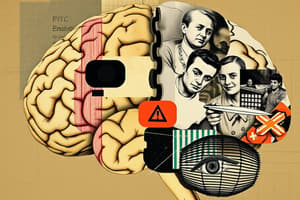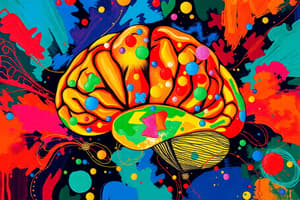Podcast
Questions and Answers
What is the primary function of the medulla?
What is the primary function of the medulla?
- Processing sensory information
- Regulating emotional responses
- Coordinating eye movements
- Controlling basic vegetative processes (correct)
Which structure serves as a relay station for sensory information to the cortex?
Which structure serves as a relay station for sensory information to the cortex?
- Basal Ganglia
- Cerebellum
- Thalamus (correct)
- Hypothalamus
What role does the pons play in the brain?
What role does the pons play in the brain?
- It links the cerebellum to the rest of the brain (correct)
- It controls basic vegetative processes
- It is involved in emotional regulation
- It regulates body temperature
Which brain structure is associated with balance and skilled movement execution?
Which brain structure is associated with balance and skilled movement execution?
What is the primary function of the basal ganglia?
What is the primary function of the basal ganglia?
What process involves transforming stem cells into specialized neurons and glial cells?
What process involves transforming stem cells into specialized neurons and glial cells?
Which part of the brain is involved in controlling behaviors related to homeostasis?
Which part of the brain is involved in controlling behaviors related to homeostasis?
What is one consequence of damage to the limbic system?
What is one consequence of damage to the limbic system?
What did Gall primarily focus on regarding brain functions?
What did Gall primarily focus on regarding brain functions?
What was a significant finding from Broca's work with patient 'Tan'?
What was a significant finding from Broca's work with patient 'Tan'?
Which type of aphasia allows a patient to speak normally but convey little meaningful content?
Which type of aphasia allows a patient to speak normally but convey little meaningful content?
In neuropsychology, what is the primary aim of studying anatomo-clinical correlations?
In neuropsychology, what is the primary aim of studying anatomo-clinical correlations?
Which patient is known for experiencing a personality change due to brain injury?
Which patient is known for experiencing a personality change due to brain injury?
What is the primary cognitive difficulty experienced by individuals with prosopagnosia?
What is the primary cognitive difficulty experienced by individuals with prosopagnosia?
What impairment did H.M. experience after the removal of his hippocampus?
What impairment did H.M. experience after the removal of his hippocampus?
Which part of the brain is primarily associated with damage leading to associative prosopagnosia?
Which part of the brain is primarily associated with damage leading to associative prosopagnosia?
What type of aphasia does a patient with disconnection between Wernicke’s area and Broca’s area typically experience?
What type of aphasia does a patient with disconnection between Wernicke’s area and Broca’s area typically experience?
How does someone with apperceptive prosopagnosia typically process faces?
How does someone with apperceptive prosopagnosia typically process faces?
What was one of Gall's significant contributions to neuroscience?
What was one of Gall's significant contributions to neuroscience?
What percentage of the population is estimated to have some form of prosopagnosia?
What percentage of the population is estimated to have some form of prosopagnosia?
Which of the following best describes the difference between perceptual processes and associative processes in prosopagnosia?
Which of the following best describes the difference between perceptual processes and associative processes in prosopagnosia?
What alternative recognition strategies do individuals with prosopagnosia rely on?
What alternative recognition strategies do individuals with prosopagnosia rely on?
Which condition is most commonly associated with prosopagnosia?
Which condition is most commonly associated with prosopagnosia?
What role does the fusiform gyrus play in prosopagnosia?
What role does the fusiform gyrus play in prosopagnosia?
What is a core feature of Broca's aphasia?
What is a core feature of Broca's aphasia?
What type of speech is commonly associated with Broca's aphasia?
What type of speech is commonly associated with Broca's aphasia?
Which of the following best describes aggramatism in Broca's aphasia?
Which of the following best describes aggramatism in Broca's aphasia?
What is often preserved in patients with Broca's aphasia despite their language difficulties?
What is often preserved in patients with Broca's aphasia despite their language difficulties?
What does 'telegraphic speech' refer to in the context of Broca's aphasia?
What does 'telegraphic speech' refer to in the context of Broca's aphasia?
Which of the following conditions can lead to aphasia?
Which of the following conditions can lead to aphasia?
How do most patients with Broca's aphasia feel about their language difficulties?
How do most patients with Broca's aphasia feel about their language difficulties?
Which of the following statements is NOT true about Broca’s aphasia?
Which of the following statements is NOT true about Broca’s aphasia?
What is a common condition experienced by approximately 85% of aphasic patients?
What is a common condition experienced by approximately 85% of aphasic patients?
Which type of aphasia is characterized by difficulties in understanding sentences with reversible roles?
Which type of aphasia is characterized by difficulties in understanding sentences with reversible roles?
Which of the following is a consequence of the syntactic disturbances in aphasic patients?
Which of the following is a consequence of the syntactic disturbances in aphasic patients?
In the context of syntactic structures, what do syntactic trees help to establish?
In the context of syntactic structures, what do syntactic trees help to establish?
What role does lexical semantics play in language?
What role does lexical semantics play in language?
Which area of the brain is NOT associated with syntactic processing?
Which area of the brain is NOT associated with syntactic processing?
What is agrammatism most commonly associated with in aphasic patients?
What is agrammatism most commonly associated with in aphasic patients?
What is a key function of semantic lexicons?
What is a key function of semantic lexicons?
What primary factor allows MRI scanners to detect changes in magnetic signals from the body?
What primary factor allows MRI scanners to detect changes in magnetic signals from the body?
How does functional magnetic resonance imaging (fMRI) differ from structural MRI?
How does functional magnetic resonance imaging (fMRI) differ from structural MRI?
What is the BOLD response primarily a measure of in fMRI?
What is the BOLD response primarily a measure of in fMRI?
Which property of oxygenated hemoglobin is key for fMRI detection?
Which property of oxygenated hemoglobin is key for fMRI detection?
What is a limitation of fMRI compared to techniques like EEG?
What is a limitation of fMRI compared to techniques like EEG?
What occurs during the haemodynamic response in activated brain areas?
What occurs during the haemodynamic response in activated brain areas?
In what plane can fMRI images be obtained?
In what plane can fMRI images be obtained?
What happens to oxygen levels related to active neurons during fMRI?
What happens to oxygen levels related to active neurons during fMRI?
Flashcards
Phrenology
Phrenology
The idea that bumps on the skull correspond to specific mental abilities.
Neuropsychology
Neuropsychology
The study of the relationship between cognitive functions and their underlying brain structures.
Cerebral Cortex
Cerebral Cortex
The outer layer of the brain responsible for higher-level cognitive functions.
Broca's Aphasia
Broca's Aphasia
Signup and view all the flashcards
Wernicke's Aphasia
Wernicke's Aphasia
Signup and view all the flashcards
Broca's Area
Broca's Area
Signup and view all the flashcards
Wernicke's Area
Wernicke's Area
Signup and view all the flashcards
Conduction Aphasia
Conduction Aphasia
Signup and view all the flashcards
Medulla
Medulla
Signup and view all the flashcards
Pons
Pons
Signup and view all the flashcards
Cerebellum
Cerebellum
Signup and view all the flashcards
Hypothalamus
Hypothalamus
Signup and view all the flashcards
Thalamus
Thalamus
Signup and view all the flashcards
Basal Ganglia
Basal Ganglia
Signup and view all the flashcards
Limbic System
Limbic System
Signup and view all the flashcards
Neurogenesis
Neurogenesis
Signup and view all the flashcards
Prosopagnosia
Prosopagnosia
Signup and view all the flashcards
Occipital Face Area (OFA)
Occipital Face Area (OFA)
Signup and view all the flashcards
Apperceptive Prosopagnosia
Apperceptive Prosopagnosia
Signup and view all the flashcards
Associative Prosopagnosia
Associative Prosopagnosia
Signup and view all the flashcards
Acquired Prosopagnosia
Acquired Prosopagnosia
Signup and view all the flashcards
Developmental Prosopagnosia
Developmental Prosopagnosia
Signup and view all the flashcards
Feature-by-Feature Recognition
Feature-by-Feature Recognition
Signup and view all the flashcards
Multimodal Recognition
Multimodal Recognition
Signup and view all the flashcards
What is Neuroimaging?
What is Neuroimaging?
Signup and view all the flashcards
What is structural MRI?
What is structural MRI?
Signup and view all the flashcards
How does structural MRI detect different brain tissues?
How does structural MRI detect different brain tissues?
Signup and view all the flashcards
What is fMRI?
What is fMRI?
Signup and view all the flashcards
How does fMRI work?
How does fMRI work?
Signup and view all the flashcards
What is the BOLD response?
What is the BOLD response?
Signup and view all the flashcards
What is fMRI's spatial resolution?
What is fMRI's spatial resolution?
Signup and view all the flashcards
What is fMRI's temporal resolution?
What is fMRI's temporal resolution?
Signup and view all the flashcards
Syntactic Structure
Syntactic Structure
Signup and view all the flashcards
Syntactic Comprehension
Syntactic Comprehension
Signup and view all the flashcards
Syntactic Production
Syntactic Production
Signup and view all the flashcards
Thematic Role Assignment
Thematic Role Assignment
Signup and view all the flashcards
Lexical Semantics
Lexical Semantics
Signup and view all the flashcards
Lexicon
Lexicon
Signup and view all the flashcards
Aphasia
Aphasia
Signup and view all the flashcards
Syndrome
Syndrome
Signup and view all the flashcards
Aphasic Syndrome
Aphasic Syndrome
Signup and view all the flashcards
Broca's Aphasia Speech Characteristics
Broca's Aphasia Speech Characteristics
Signup and view all the flashcards
Agrammatism
Agrammatism
Signup and view all the flashcards
Preserved Comprehension in Broca's Aphasia
Preserved Comprehension in Broca's Aphasia
Signup and view all the flashcards
Insight in Broca's Aphasia
Insight in Broca's Aphasia
Signup and view all the flashcards
Study Notes
Nervous System
- The nervous system is composed of two fundamental cell types: neurons and glia.
- Neurons transmit electrical impulses, communicating with other neurons or muscles.
- A human brain has 100 to 150 billion neurons.
- Glia cells support neurons; oligodendrocytes form myelin sheaths, microglia remove damaged tissue, and astrocytes regulate substance transfer between blood and brain.
Nervous Systems
- Central Nervous System (CNS): brain and spinal cord.
- Peripheral Nervous System (PNS): includes skeletal (voluntary muscles) and autonomic (involuntary muscles, such as heart) systems. Sensory (afferent) neurons carry signals to the brain, efferent neurons carry signals away from the brain.
Gray Matter vs White Matter
- Gray matter contains neuronal cell bodies (40% of brain).
- White matter contains bundles of axons connecting gray matter areas (60% of brain).
Organization of the Brain
- The brain has four main regions: cerebrum, cerebellum, brainstem (hindbrain), and diencephalon.
- Somatosensory information travels from the body to the somatosensory cortex.
- Motor commands travel from the motor cortex to innervate muscles.
Blood Supply
- Cerebral arteries supply oxygenated blood to the brain.
- Cerebral veins drain deoxygenated blood.
- The blood-brain barrier protects the brain from harmful elements.
Cerebrospinal Fluid (CSF)
- CSF is a clear, colorless fluid that protects the brain and spinal cord.
- CSF circulates around the CNS, facilitating nutrient and chemical diffusion.
Decussation
- Decussation refers to the crossing of nerve fibers in the brainstem, allowing contralateral control.
Studying That Suits You
Use AI to generate personalized quizzes and flashcards to suit your learning preferences.




